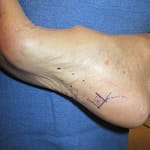
1/25/2022
PITTSBURGH – A novel technique that transplants a patient’s own fat into the sole of their foot could offer relief to those suffering from a common and painful condition called plantar fasciitis, according to University of Pittsburgh School of Medicine researchers.
In a pilot study, published today in Plastic and Reconstructive Surgery and led by a wife-and-husband team, the fat injection procedure improved symptoms of plantar fasciitis in patients, laying the groundwork for a larger clinical trial.
 “We developed this procedure to harness the regenerative properties of fat,” said Jeffrey Gusenoff, M.D., professor of plastic surgery at Pitt. “In this proof-of-concept study, we showed that fat injections into the foot reduced heel pain, helped patients get back to doing sports and activities and boosted quality of life.”
“We developed this procedure to harness the regenerative properties of fat,” said Jeffrey Gusenoff, M.D., professor of plastic surgery at Pitt. “In this proof-of-concept study, we showed that fat injections into the foot reduced heel pain, helped patients get back to doing sports and activities and boosted quality of life.”
Plantar fasciitis, or PF, is one of the most common causes of heel pain, affecting about 2 million people in the United States. It’s caused by inflammation of the plantar fascia, connective tissue that runs from the heel to the toes and supports the foot arch.
 "Plantar fasciitis is exceptionally painful,” said Beth Gusenoff, D.P.M., clinical assistant professor of plastic surgery at Pitt. “When you get up from a sitting position or from sleeping, it’s a sharp, searing pain that some people describe as being like a nail going right through their heel.”
"Plantar fasciitis is exceptionally painful,” said Beth Gusenoff, D.P.M., clinical assistant professor of plastic surgery at Pitt. “When you get up from a sitting position or from sleeping, it’s a sharp, searing pain that some people describe as being like a nail going right through their heel.”
The acute form of PF can be treated with stretching, shoe orthotics or cortisone injections. But about 10% of patients progress to the chronic form in which the foot’s collagen degenerates and the plantar fascia thickens. For these patients, surgical release of the plantar fascia with a small cut can help, but this surgery comes with risks, according to Beth Gusenoff.
“Recently, there has been a plea among podiatrists to stop cutting the plantar fascia because some people get a lot of scar tissue, which causes pain,” she explained. “And if too much is cut, the foot can become destabilized, so people end up with almost like a floppy foot.”
Inspired by the regenerative properties of fat stem cells, the Gusenoffs developed a technique that uses fat harvested from a patient’s belly or other body area.
 “In fat, there are stem cells and growth factors that help bring in fresh blood supply, which drives a mode of wound healing with reduced scarring,” explained Jeffrey Gusenoff. “We use a blunt needle to perforate the plantar fascia, which makes a small injury to stimulate the healing process. Then, when we pull the needle back, we inject a little bit of the patient’s fat.”
“In fat, there are stem cells and growth factors that help bring in fresh blood supply, which drives a mode of wound healing with reduced scarring,” explained Jeffrey Gusenoff. “We use a blunt needle to perforate the plantar fascia, which makes a small injury to stimulate the healing process. Then, when we pull the needle back, we inject a little bit of the patient’s fat.”
To test this method, the team recruited 14 patients with chronic PF and split them into two groups. Group 1 participants received the procedure at the beginning of the study and were followed for 12 months, and their Group 2 counterparts received the procedure after a six-month observation period and were followed for an additional six months.
“We found that Group 1 had improvements in quality of life and sports activity, decreased plantar fascia thickness and reduced pain levels,” said Jeffrey Gusenoff. “And a lot of the measures that were improving six months after the procedure got even better by 12 months.”
Similarly, Group 2 showed decreased plantar fascia thickness and increased sports activity six months after the procedure, and there was a slight, but not statistically significant, improvement in pain levels. With a larger sample size and a longer follow-up time, the researchers said it’s likely they would have seen stronger improvements in this group.
According to the Gusenoffs, this study provides proof-of-concept that fat injections can treat PF, and they now are planning a larger clinical trial to validate these findings. With enough evidence, they hope that the procedure will be deemed a medical necessity so that it can be covered by insurance and become more widely available in the future.
In previous work, the Gusenoffs showed that fat injections can help solve another type of foot pain caused by loss of the fat pads that cushion the ball of the foot and heel.
This research was supported by the Virginia Kaufman Pain Research Challenge.
Danielle Minteer, Ph.D., formerly of Pitt, was an additional author of this study.
PHOTO INFO: (click images for high-res versions)
Top:
CREDIT: UPMC
CAPTION: Jeffrey Gusenoff, M.D., professor of plastic surgery, University of Pittsburgh School of Medicine.
Middle:
CREDIT: UPMC
CAPTION: Beth Gusenoff, D.P.M., clinical assistant professor of plastic surgery, University of Pittsburgh School of Medicine.
Bottom:
CREDIT: Gusenoff et al. 2022. Plast. Reconstr. Surg.
CAPTION: University of Pittsburgh researchers have developed a new method for treating a painful foot condition called plantar fasciitis. A patient’s own fat is injected into the foot via dozens of small injections in a grid pattern.
















